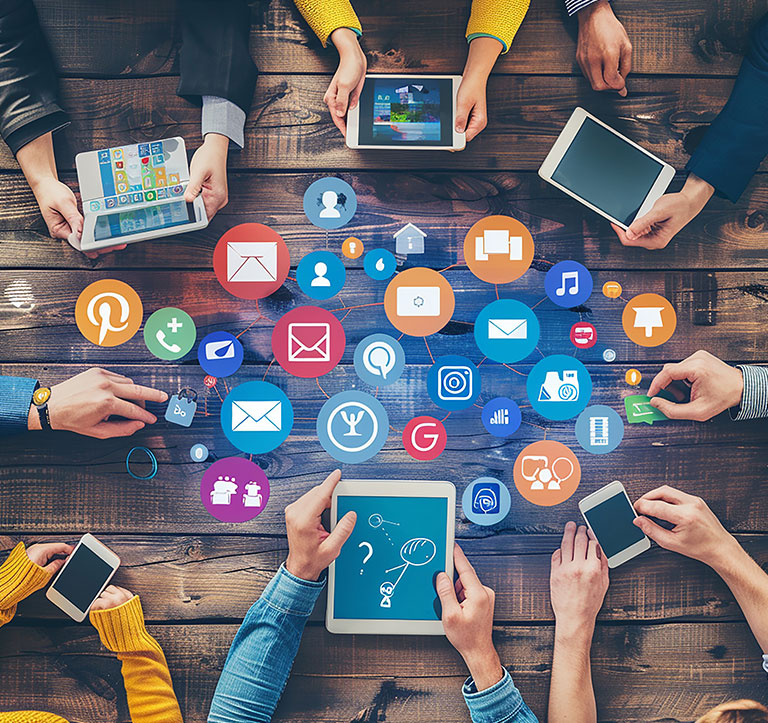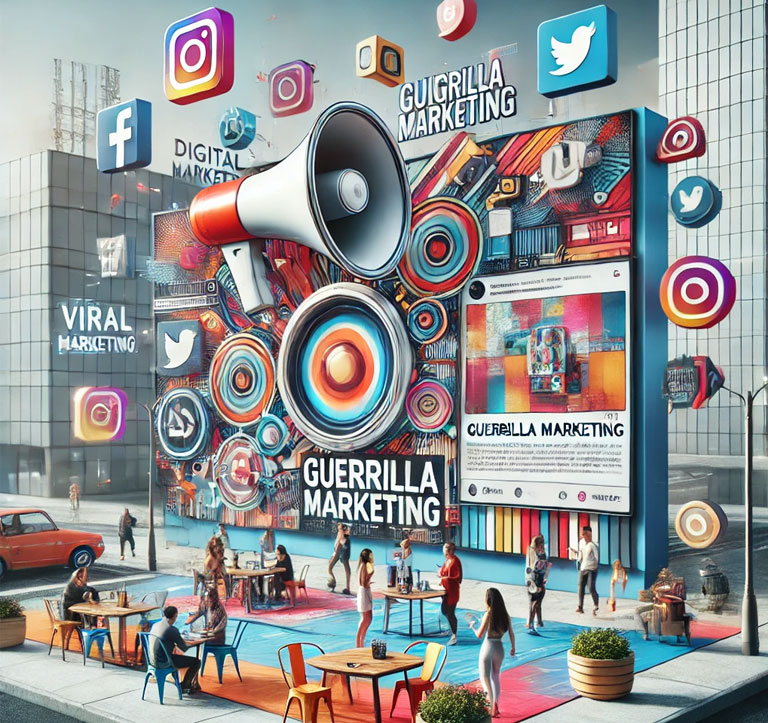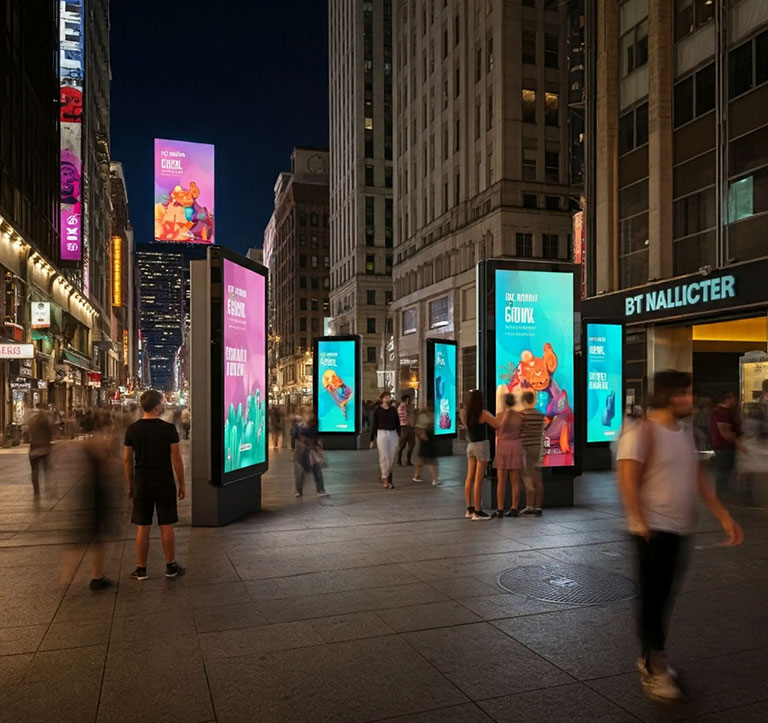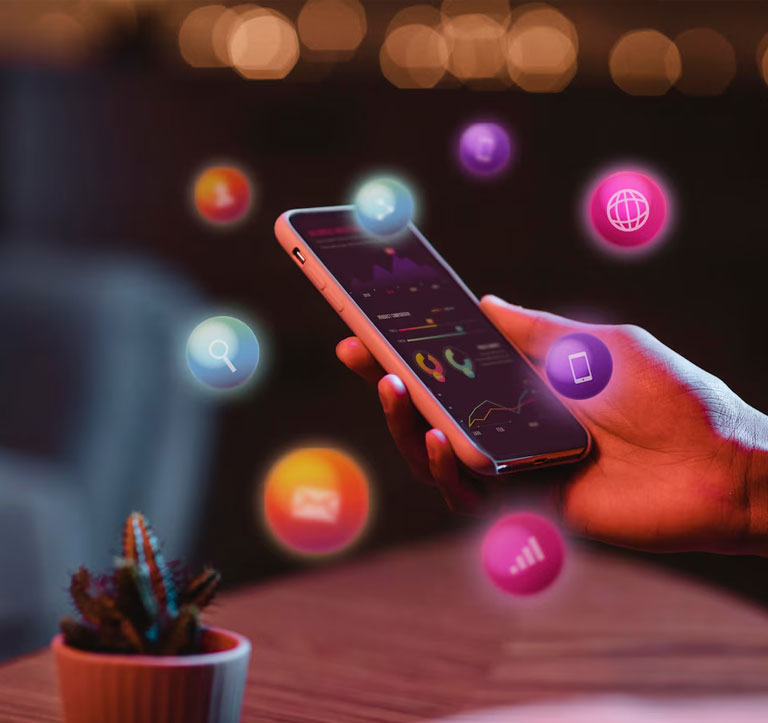Share Article :
Introduction to Guerrilla Marketing and Digital Marketing Synergy
Guerrilla Marketing can be defined as a form of advertising that focuses on unconventional, creative tactics that leverage low-cost strategies to create a significant buzz. Unlike traditional marketing, which often relies on large budgets and standardized campaigns, guerrilla marketing emphasizes ingenuity, surprise, and emotional resonance. This approach is particularly effective because it stands out from the noise and captures the audience’s attention in unexpected ways.
On the other hand, digital marketing refers to the use of online platforms and technologies to promote products and services. It offers fast reach, broad impact, and cost-efficiency, making it the perfect companion to guerrilla marketing tactics. By blending the creative, disruptive nature of guerrilla marketing with the broad, accessible tools of digital marketing, businesses can maximize their reach and engagement. The synergy between guerrilla and digital marketing lies in their ability to complement each other’s strengths.

Furthermore, digital marketing provides a versatile and highly scalable platform for guerrilla campaigns, allowing marketers to quickly test different creative ideas and adjust them based on feedback. For example, social media platforms like Instagram, TikTok, and Twitter are ideal for generating a buzz and spreading a guerrilla campaign to a large audience at little to no cost. Through these platforms, guerrilla marketing can quickly go viral, reaching audiences beyond traditional advertising’s reach.
Moreover, guerrilla marketing is especially important in today’s cluttered digital landscape. Consumers are bombarded with countless advertisements every day, and the average person has learned to tune out many of these messages. This is where guerrilla marketing comes in; its unconventional nature cuts through the clutter, offering something unexpected and memorable that captures the audience’s attention. When combined with the broad reach of digital marketing, these tactics can create a powerful impact that resonates with consumers and motivates them to take action.
Additionally, guerrilla marketing’s emphasis on creativity and out-of-the-box thinking allows companies of all sizes to compete on a level playing field. With digital platforms acting as equalizers, even small businesses with limited budgets can leverage guerrilla marketing to reach their target audience effectively. By understanding the target audience and crafting campaigns that speak directly to them, businesses can create emotional connections and inspire consumer loyalty.
In conclusion, guerrilla marketing and digital marketing are a perfect match for companies looking to break free from traditional advertising limitations. The fusion of creative, low-cost tactics with digital platforms’ broad reach allows brands to generate significant awareness, engagement, and loyalty in today’s competitive market.
Identifying the Target Audience

Identifying the right target audience is a crucial first step in developing any guerrilla marketing campaign. Without understanding who you are trying to reach, it is nearly impossible to craft messages that resonate or create the desired impact. Therefore, pinpointing niche markets for more precise messaging is essential. By narrowing down the audience, you can ensure that your marketing efforts are more personalized and relevant.
To begin, it is important to gather as much data as possible about your potential customers. This can be done through various means, such as surveys, focus groups, or leveraging customer data from existing sales. By analyzing this data, you can start to see patterns in demographics, interests, behaviors, and pain points. This insight will help you build detailed audience personas that can guide your messaging and creative approach.
Additionally, using digital tools like analytics, social listening, and persona mapping can provide deeper insights into your audience. Digital analytics tools, such as Google Analytics, can help you understand who is visiting your website, where they are coming from, and what content they are engaging with the most. These insights are invaluable for pinpointing the target audience and understanding how best to reach them.
Moreover, social listening tools can offer real-time insights into what people are saying about your brand, your competitors, and relevant industry topics. By listening to what your audience is talking about and identifying their pain points, you can uncover opportunities to surprise and delight them with guerrilla marketing tactics. Social media platforms like Twitter and Instagram also provide direct access to consumer conversations, making it easier to understand what resonates with your target market.
Furthermore, persona mapping is another useful technique that involves creating semi-fictional representations of your ideal customers. By building these personas, you can visualize your target audience in a more concrete way, which helps in tailoring your guerrilla marketing campaigns to meet their specific needs, desires, and preferences. Personas are particularly helpful in making sure that the messaging feels personal and relevant to the individuals you are trying to reach.
Finally, it is essential to continually refine and adapt your understanding of the target audience. The market is constantly changing, and so are customer preferences and behaviors. By regularly reviewing your audience data and updating your personas, you can stay ahead of the curve and ensure that your guerrilla marketing campaigns remain relevant and impactful. This constant refinement process is key to creating campaigns that not only capture attention but also drive meaningful engagement and brand loyalty.
Leveraging Creativity for Impact
Creativity is at the heart of guerrilla marketing, and leveraging it effectively can make all the difference in achieving impactful campaigns. To start, it is crucial to focus on creating surprising campaigns that capture attention and leave a lasting impression. This often involves using unexpected and memorable content, such as viral videos, humorous memes, or unexpected pop-ups that grab attention immediately. For instance, a well-crafted video that takes an unexpected twist can quickly go viral, especially if it connects with the audience on an emotional level. By incorporating an element of surprise, brands can break through the noise and create a unique experience that audiences are likely to share.

Furthermore, encouraging User-Generated Content (UGC) is another powerful way to leverage creativity. By involving the audience in the campaign itself, you not only increase engagement but also foster a sense of community and brand loyalty. For example, creative challenges or contests that invite followers to share their experiences with the brand can generate a wealth of authentic content. This type of content often performs better because it is relatable and trustworthy, coming directly from real users. As a result, UGC can be a highly effective tool for amplifying the reach and impact of a guerrilla marketing campaign.
In addition, using visual storytelling is a powerful way to leverage creativity for impact. Visual elements, such as images, animations, and videos, can quickly convey complex ideas and evoke strong emotions. By telling a compelling story that ties into the brand’s values and mission, you can create a deeper connection with the audience. For instance, brands can use animated videos to highlight how their products solve everyday problems in a fun and engaging way. The combination of visuals and narrative helps to make the message more memorable and impactful.
Moreover, the use of interactive content can greatly enhance the creative impact of guerrilla marketing campaigns. Interactive content, such as quizzes, polls, or augmented reality (AR) experiences, invites the audience to actively participate rather than passively consume. This level of engagement helps to create a stronger bond between the brand and its audience. For instance, an AR filter on Instagram that allows users to interact with branded elements can create a fun, shareable experience that draws in more users and generates excitement around the campaign.
Additionally, leveraging influencer collaborations with a creative twist can amplify the reach of guerrilla campaigns. By partnering with influencers who have a deep connection with their audience, brands can craft authentic and unique endorsements that resonate more powerfully. Influencers can add their own personal touch to the campaign, making it feel more genuine and less like a traditional advertisement. For example, an influencer might create a humorous skit featuring a product, adding an element of entertainment that encourages followers to share the content.
Finally, it is important to continuously experiment with new ideas and formats to keep the creativity flowing. Guerrilla marketing thrives on innovation, and by trying out different creative approaches, you can discover what resonates best with your audience. Whether it’s experimenting with new visual styles, trying out different forms of interactive content, or launching surprise flash events, the key is to keep the audience intrigued and engaged. This continuous cycle of creativity and experimentation ensures that the brand remains fresh and exciting, ultimately driving a lasting impact on the audience.
Building Emotional Connections

Emotional connections are key to making guerrilla marketing campaigns truly resonate with audiences. One of the most effective ways to build these connections is by using storytelling as a core element of guerrilla marketing on social platforms. Through storytelling, brands can communicate their values, mission, and personality in a relatable and compelling way. A good story draws people in and makes them feel connected to the brand. For example, a story about how a brand’s product has made a real difference in someone’s life can evoke empathy and establish a powerful emotional bond with potential customers.
Furthermore, campaigns that evoke emotions such as humor, empathy, or excitement tend to perform better because they are memorable and relatable. Humor can be particularly effective in creating positive associations with the brand. A funny, unexpected video or meme can make audiences laugh, share, and talk about the brand, creating a buzz. On the other hand, empathy-driven campaigns that highlight social or community issues can foster deeper connections with audiences who share those concerns. By aligning with causes that matter to their audience, brands can build loyalty and a sense of shared values.
Additionally, using emotional visuals is another strategy for building emotional connections. Visual elements such as imagery, color schemes, and music can evoke strong emotions and help convey the brand’s story more powerfully. For instance, a touching video that shows real people benefiting from a product can evoke feelings of happiness and trust, while a high-energy, action-packed clip can convey excitement and inspire viewers to take action. These emotional cues help create a lasting impression that sticks with the audience long after the campaign is over.
Moreover, engaging the audience through interactive experiences can also strengthen emotional bonds. When consumers actively participate in a campaign—such as sharing their personal stories, voting in polls, or taking part in live events—they feel a sense of ownership and connection to the brand. This participation not only creates a memorable experience but also makes the audience feel valued and heard, fostering loyalty.
Finally, it is important to be authentic in every aspect of the campaign. Authenticity is the foundation of trust, and consumers can easily detect when a brand’s messaging feels forced or insincere. By being genuine and transparent, brands can build a foundation of trust that forms the basis for long-term emotional connections. Whether it’s sharing behind-the-scenes content, showcasing real testimonials, or engaging in meaningful community initiatives, authenticity should be at the heart of every guerrilla marketing effort.
Tactical Deployment Across Channels

Successfully deploying guerrilla marketing tactics across different channels is essential for maximizing reach and impact. To begin, using social media platforms is one of the most effective ways to create buzz and drive engagement. Platforms like TikTok and Instagram offer interactive formats such as challenges, Reels, and Stories that can be used to create viral campaigns. By leveraging the unique features of each platform, brands can craft campaigns that resonate with users in a fun and shareable way. For example, a TikTok dance challenge can quickly gain traction and encourage user participation, resulting in organic growth and increased visibility.
Additionally, influencer collaboration is a powerful way to deploy guerrilla marketing tactics. By partnering with micro-influencers who have a genuine connection with their audience, brands can create authentic endorsements that feel more personal and trustworthy. Influencers can introduce creative guerrilla elements into their content—such as live streams, unboxing experiences, or humorous skits—helping to amplify the campaign’s reach. This kind of collaboration not only increases the brand’s credibility but also helps in reaching specific niche audiences effectively.
Moreover, email marketing is another channel that can be used creatively for guerrilla campaigns. Unlike traditional email marketing, guerrilla email campaigns are more personalized and unexpected, often containing compelling subject lines or unique visuals to capture attention. For example, a humorous or thought-provoking subject line can entice the recipient to open the email, while the content itself can offer surprises, such as exclusive offers or entertaining videos. These unexpected touches help create a memorable experience and encourage recipients to engage further with the brand.
Furthermore, content repurposing across multiple channels can enhance the campaign’s overall effectiveness. For instance, a successful guerrilla marketing video on TikTok can be repurposed into shorter clips for Instagram Stories or adapted into a GIF for Twitter. By tailoring content to fit each platform’s specific format and audience, brands can ensure that their message is consistent while maximizing exposure across various channels. This cohesive approach helps in reaching different audience segments effectively, ultimately boosting the campaign’s impact.
Finally, using offline-to-online integration is another tactical approach that can bridge the gap between physical and digital experiences. For example, a guerrilla street stunt or event can be recorded and shared online, turning a local experience into a viral digital campaign. This kind of integration allows the brand to amplify the reach of their offline efforts and create an even bigger impact through digital amplification.
Leveraging Digital PR & Buzz
Creating buzz is at the core of guerrilla marketing, and leveraging digital PR is a crucial component for gaining attention. To start, gaining coverage from blogs and news outlets with share-worthy campaigns can help amplify reach significantly. A creative guerrilla marketing stunt that is unique, visually captivating, or controversial can attract the attention of media outlets, resulting in free publicity. For instance, brands can stage events or stunts that are newsworthy and then share these moments on social media to increase exposure further.

Moreover, engaging in strategic PR stunts is an effective way to create media coverage and generate online buzz. A well-timed PR stunt can capture the attention of journalists, bloggers, and social media influencers, leading to increased coverage across various platforms. For example, organizing a flash mob in a crowded urban area or launching a unique experiential event can provide the perfect photo opportunity that news outlets and content creators are eager to share. This, in turn, helps amplify brand visibility and drives conversation around the campaign.
Additionally, using press releases creatively can help build digital buzz. Press releases that contain elements of surprise, humor, or storytelling are more likely to be picked up by media outlets. Brands can incorporate multimedia elements such as videos, GIFs, or infographics to make press releases more engaging and visually appealing, increasing the likelihood of gaining coverage.
Furthermore, leveraging social media influencers and brand advocates to share the campaign can enhance PR efforts and generate organic buzz. By partnering with influencers who align with the brand’s values and audience, companies can reach a wider audience while adding an authentic voice to the campaign. Influencers can share their reactions to a guerrilla stunt or provide behind-the-scenes content, which helps humanize the brand and encourages followers to share their thoughts and experiences.
Finally, it is important to monitor the online conversation and engage with audiences to sustain the buzz. By actively engaging with comments, questions, and mentions across social media platforms, brands can keep the conversation going and demonstrate that they are listening to their audience. Responding in a timely and personable manner not only keeps people interested but also helps in building a positive image of the brand.
Utilizing Analytics for Adaptation

Analytics play a vital role in the success of guerrilla marketing campaigns by helping brands understand what works and what doesn’t. To begin, it is essential to track campaign performance using tools like Google Analytics, social media insights, and A/B testing. These tools provide valuable data on user engagement, reach, and conversion rates, which can help marketers determine the effectiveness of their tactics. For example, tracking how many people interacted with a guerrilla video on social media can provide insights into its resonance and reach.
Moreover, using A/B testing can help marketers identify which creative elements are performing best. By testing different versions of ads, visuals, or copy, brands can determine what resonates most with their audience and make data-driven decisions to optimize their campaigns. This iterative process ensures that the campaign stays relevant and effective in achieving its goals.
Additionally, social media insights can provide real-time feedback on how audiences are responding to the campaign. Metrics such as likes, shares, comments, and mentions offer valuable insights into how well the campaign is being received. By analyzing this data, brands can adapt their guerrilla tactics based on audience preferences and behaviors. For example, if a particular post receives high engagement, similar content can be created to maintain momentum.
Furthermore, leveraging heatmaps and engagement metrics can help brands understand how users interact with campaign-specific landing pages or websites. By analyzing which parts of a page are drawing the most attention, marketers can identify areas that need improvement and optimize the user experience. This level of insight is crucial for ensuring that every aspect of the campaign is working towards achieving the desired impact. Finally, it is important to quickly pivot and adapt guerrilla tactics based on audience feedback and campaign data. Guerrilla marketing often involves taking risks, and not all ideas will resonate as expected. By monitoring performance metrics and being willing to make changes, brands can ensure that their campaigns remain impactful and relevant. Whether it means tweaking a message, changing visuals, or adjusting the campaign timeline, adaptability is key to guerrilla marketing success.
Examples of Digital Guerrilla Marketing Success
Looking at successful real-life examples can provide valuable insights into how guerrilla marketing works in practice. One of the most notable examples is Dollar Shave Club’s viral video, which used humor and an unconventional approach to introduce the brand. The video was highly shareable and resonated with audiences, leading to massive brand awareness and growth. By embracing humor and a unique tone, Dollar Shave Club was able to connect with its target audience in an authentic way that set it apart from competitors.

Similarly, Old Spice’s response videos showcased the power of creativity and real-time engagement. Old Spice’s campaign involved creating personalized video responses to social media users, which generated significant buzz and engagement. The campaign’s humor, creativity, and timely responses helped it go viral, demonstrating the effectiveness of guerrilla marketing in building brand loyalty and visibility.
Another example is Red Bull’s Stratos Jump, where Red Bull sponsored a skydiver to jump from the edge of space. The event was live-streamed and gained massive media coverage, showcasing the brand’s commitment to pushing boundaries and creating thrilling experiences. This campaign not only reinforced Red Bull’s brand image as adventurous and extreme but also generated substantial online buzz and media attention.
Lessons learned from these campaigns highlight the importance of embracing creativity, taking calculated risks, and leveraging the element of surprise. By understanding what made these campaigns resonate with audiences, marketers can apply similar principles to their own guerrilla efforts. Whether it’s using humor, creating interactive experiences, or engaging in real-time conversations, these campaigns demonstrate how guerrilla tactics can effectively capture attention and drive brand growth.
Ethical Considerations and Brand Alignment
When implementing guerrilla marketing campaigns, it is crucial to consider ethical implications and ensure that the tactics align with the brand’s values and message. To start, brands must avoid using tactics that may be perceived as offensive, insensitive, or overly disruptive. While guerrilla marketing often involves pushing boundaries, it is important to strike the right balance between creativity and respect for the audience. Tactics that come across as intrusive or manipulative can damage the brand’s reputation and alienate potential customers.
Furthermore, ensuring transparency in all aspects of the campaign is essential for maintaining trust. Guerrilla marketing tactics should never deceive or mislead the audience. For instance, if a campaign involves influencers, it is important that they clearly disclose their relationship with the brand. Transparency helps in building credibility and fosters a sense of honesty that consumers value.
Additionally, guerrilla campaigns should be inclusive and avoid stereotyping or alienating specific groups. Marketers should take care to craft messages that are respectful and resonate positively with a diverse audience. By being mindful of cultural differences and avoiding potentially offensive imagery or language, brands can create campaigns that are inclusive and appealing to a wide range of consumers.
Moreover, brands should ensure that their guerrilla tactics are environmentally responsible. Campaigns that involve physical installations or events should consider their environmental impact and take steps to minimize waste. For example, using sustainable materials or ensuring that installations are easy to dismantle and recycle can demonstrate the brand’s commitment to environmental responsibility.

Finally, aligning the campaign with the brand’s core values is crucial for creating an authentic connection with the audience. Guerrilla marketing is most effective when it reflects what the brand stands for and communicates its mission in a compelling way. By ensuring that every element of the campaign is aligned with the brand’s identity, marketers can build a cohesive and genuine message that resonates with the target audience and reinforces the brand’s positioning.
Conclusion: Tying Guerrilla Tactics to Digital Growth
In conclusion, guerrilla marketing, when applied effectively in the digital space, has the potential to generate significant brand awareness, engagement, and loyalty. By embracing creativity, surprise, and emotional resonance, brands can create campaigns that cut through the noise and capture the audience’s attention in memorable ways. The combination of guerrilla tactics and digital marketing platforms provides an opportunity to reach a broad audience at a low cost, making it a powerful approach for brands of all sizes.
Furthermore, the key to long-term success with guerrilla marketing lies in continual experimentation, creativity, and adaptability. The digital landscape is constantly evolving, and consumer preferences change rapidly. Brands that are willing to take risks, experiment with new ideas, and adapt their tactics based on audience feedback will be best positioned to succeed in the competitive market. By keeping the audience engaged and intrigued through creative and authentic campaigns, guerrilla marketing can be a driving force for digital growth and brand loyalty.
Share Article :
